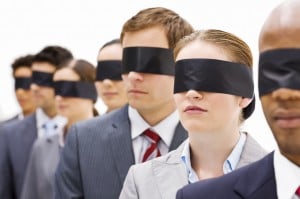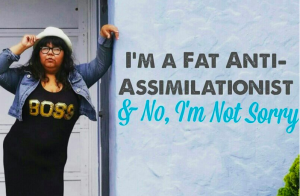So, you’ve head about oppression and privilege right? Well, what if I told you that there’s a form of oppression that you, and I, may be participating in that we are unaware of?
Xenophobia is the word used for people that have a discomfort, dislike, or a fear of people whom they perceive to be outsiders, and/or from other countries – a fear which, in the United States, is rooted in White Supremacy.
“But I’m an anti–racist feminist, I don’t participate in Xenophobia!”
Actually, anti-racists feminist can, and do, participate in xenophobia, often times without even knowing it.
Because United States culture privileges the realities of White immigrants, such as figures like Christopher Columbus and the pilgrims, the realities of migrants of color, especially the undocumented, refugees, and those seeking political asylum are silenced and pushed away.
In my own experience as a Latin American immigrant, I perpetuated xenophobic thoughts by believing that I was better fit to be in the United States than my counterpart Middle Eastern migrants. I thought like this because after 9/11, I was taught by a racist media and political regime to see Middle Eastern, and especially Islamic folks as terrorists.
And because I didn’t yet realize how intentional media programing is, and how corrupt the United States government is – especially when it comes to foreign policy, war, and imperialism – I was privileging Latin American migrants by pinning and uplifting those realities against Middle Eastern migrants.
I was xenophobic, and I didn’t even know about it!
But how did this start? Where did I learn it?
Xenophobia Begins with the Lie That the Pilgrims Were the First Immigrants
During my first year at an all-American elementary school, my 5th grade class took a fieldtrip to Plymouth Plantation. Right before the trip, however, we had a whole unit on “The Mayflower.”
I remember this unit so clearly because, as the only non-English speaker in the class, the teacher kept telling the class that the pilgrims were immigrants, just like me.
She started by explaining that the pilgrims were born in Europe, but because of political persecution, they were forced to make the most courageous decision of their time – to leave their home in the hopes of finding acceptance elsewhere.
I remember looking up to the pilgrims. I couldn’t begin to imagine what it would have been like for me to be in a boat for months and manage to survive.
When we got to Plymouth Plantation, I remember my friends reading to me some of the flyers that depicted the pilgrims as the first immigrants. Finally, I felt that I fit in with American culture despite my thick accent, my kinky hair, my dark eyes, and being the only person of color in the room.
But my whole class was taught to celebrate the courage of the pilgrims and empathize with their struggles – and never once did we learn about the Native Americans who were massacred at the expense of “the first immigrants.”
Because of the untold story of Native people who were exiled, executed, and made invisible, we perceive the United States as a nation of immigrants. But clearly and in reality, we’re not really the nation of immigrants.
The heroic story of courage and oppression that we learn about the pilgrims is all about celebrating Europeans who “earned” their “liberty” and “freedom” by creating genocide of indigenous folk.
When we celebrate the pilgrims, what we’re actually doing is celebrating White Supremacy, affirming genocide, and performing solidarity with the White men.
The United States is not a Nation of Immigrants; it is the Nation of White Supremacy.
Xenophobia Teaches Us to Only Celebrate and Empathize with White Immigrants
Since the United States is NOT a nation of immigrants, then what is its stance on immigration? Well, I’d argue that the Unites States supports immigration, as long as the immigrants are White only.
For example, have you seen the political cartoons of Native Americans building a wall to keep the Pilgrims out because the pilgrims refused to learn regional indigenous languages, customs, and ways of being? These subversive cartoons are pointing out the fact that when White folk came to the United States, undocumented, everything was okay.
But, when immigrants of color come to the United States, we need to question, police, and detain them because they are, according to the media, dangerous and not to be trusted.
The narrative of the pilgrims as the first immigrants is violent because that same narrative makes immigrants of color appear as bad, as trying to take an “unearned” piece of the American pie.
The story of the pilgrims makes it seem as if the pilgrims “built” America, and when people of color come, they have to prove themselves worthy. If we do not, we are depicted as people that didn’t “work for what they have.”
In the United States, people of color have been depicted as savages, as non-human, as 3/5ths human, and most recently, as “criminals” and “illegals.” Heck, even talking about slavery in the context of migration is messed up, because we do not acknowledge that slaves were people forced into captivity, tortured, and forced to internalize their colonization.
It is time that we realize that our binary of the good immigrant versus the bad immigrant is actually representative of White supremacy versus non-complicit people of color!
In a few words, this is the root of xenophobia: privileging White Supremacy, and therefore, questioning, exiling, and criminalizing migrants of color.
Wait, Are Xenophobia and Racism The Same Thing?
They’re closely related, but not quite.
Racism is “the belief that all members of a purported race possess characteristics, abilities, or qualities specific to that race, especially so as to distinguish it as inferior or superior to another race or other races.”
With this definition, one could say that racism is intertwined with physical and cultural characteristics of an individual. However, in order for racism to take effect, there needs to be a superior race, or at least a common narrative of who is more powerful, who is better, who is smarter, etc.
In the United States, and around the globe, this is the narrative of White Supremacy, which is why racism and xenophobia are so closely aligned.
Xenophobia, unlike racism, is rooted in the otherness of a community/society. Our dominant culture – white, middle class, US American – imposes its normality by deeming those who don’t fully assimilate to, and embody, that culture in every way as foreign and outsider.
This notion of foreign and outsider essentializes the un-foreign community/society as standard, and assumes its identity and cohesion to be in danger and in need of protection from the newcomer.
As a result, racism and xenophobia meet because xenophobia manifests in negative attitudes in prejudice, in microaggressions, and in actions that systematically exclude, shame, and marginalize the community deemed other/foreign/outsider in similar ways that White people treat people of color in a White Supremacist society.
Undocumented people of color experience xenophobia in marginalizing ways that White undocumented people will not receive.
For example, in my undocumented community, two of my close friends are undocumented and European – from Albania and Romania – but they’re always assumed to be American and safe. As a formerly undocumented migrant of color, I was always deemed other.
My Browness and Blackness deemed me outsider and prone to comments like, “Get out my country,” and disturbing side comments and/or jokes, like “Show me your greencard!”
Xenophobia is a form of oppression that we participate in because of internalized White Supremacy that makes us believe that people from other countries are less than us, less “developed”, people that are “stealing American jobs”, etc.
We need to recognize xenophobic thoughts when we have them, and reflect on why we are thinking in this way, and how to change it.
Some examples of xenophobic sentiments out there are the following:
1. “We Need To Enforce Our Borders.”
This statement assumes that immigrants are dangerous to society and fails to address why people from other countries are coming to the United States undocumented: foreign policies like NAFTA that displace indigenous Mexican farmers; escaping gang recruitment; attempting to survive while transgender and of color, etc.
2. “Learn To Speak English!”
Did you know that the United States has no official language? So, when we tell other people to learn English, we are speaking from a place where we perpetuate colonization, White Supremacy, and genocide, because English is not a native language of the United States.
In addition, every time a child enters an education system that has no bilingual education curriculum, that child is forced to participate in the colonial project of xenophobia. In fact, a non-bilingual education system serves as a border for non-European, predominantly non-White, and often times, non-middle-class youth.
3. “Muslims Are Terrorists.”
The direct blame-making, exclusion, and marginalization of Muslims, especially immigrant Muslims is a form of xenophobia, because the way in which Islamophobia works is that it prevents non-Muslims from seeing Muslims as individual people as positive agents, and as part of the community.
If we want to dismantle the ways in which Islamophobia work, we need to take a close look at our own biases and the ways in which we intake information about the Muslim community.
Xenophobia does not work alone; it requires the participation of politicians, the media, and us.
Consequently, we have to educate each other on these issues instead of waiting for the Muslim community to educate us. For further resources on addressing Islamophobia, you can look here, here, and here.
4. “No, Where Are You Really From?”
Often times, we may think that we’re trying to engage in conversation with people of color by asking them where they’re from, or worse yet, where they’re really from. I would argue that we don’t necessarily do this for conversation, but to inform our decision of whether or not we are going to trust the person in front of us.
The question may seem innocent, but it is a violent wake-up call that says “you don’t belong here” to the person being questioned.
When was the last time you went up to a White person and asked them where they were really from?
5. “Don’t Go To X Neighborhood, It’s Too Dangerous.”
Believe it or not, the perceptions we have about “dangerous” neighborhoods come from a place of (un)intentional xenophobia.
When we speak of spaces that are violent, we are usually speaking about the spaces of people of color because that’s what we are taught by the media, by the local government, and by the amount of police circulation in the area. We sometimes view our own neighbors as foreigners.
It is painful when my own community tells me not to go to certain neighborhoods because there’s too many Dominicans, or too many Pakistanis, etc. These statements are xenophobic and not committed to dismantling intersectional forms of oppression, but rather, enforcing oppression.
6. “I’m Not Like Other [Insert Nationality].”
I’m not like other Mexicans were the words that came out of my mouth when I was about 15 years old. I remember sitting at lunch and my friend asking me if I thought Mexicans were aggressive. I not only said “yes,” I then followed up by saying “I’m not like other Mexicans.”
At the age of 15, I was being xenophobic to my own community by framing myself as a “good Mexican.” Unfortunately, as I began gaining consciousness, this was a phrase that I heard hundreds of times by others in my immigrant community.
Because of White Supremacy, people of color, especially immigrants of color are always forced to explain themselves, to “de-criminalize” themselves, and to protect themselves by feeding into stereotypical narratives of their home country.
We need to stop it with the good immigrant/bad immigrant narrative. If we don’t address this dilemma, we will never reach collective liberation!
***
It’s taken me a long time to be able to make sense of xenophobia, and to understand the ways in which I have perpetuated xenophobia. Even us, self-proclaimed feminists need to be weary of our language, and our everyday interactions with other people of color.
It is the only way to de-colonize our thoughts and perceptions of others.
[do_widget id=’text-101′]
Search our 3000+ articles!
Read our articles about:
Our online racial justice training
Used by hundreds of universities, non-profits, and businesses.
Click to learn more





















